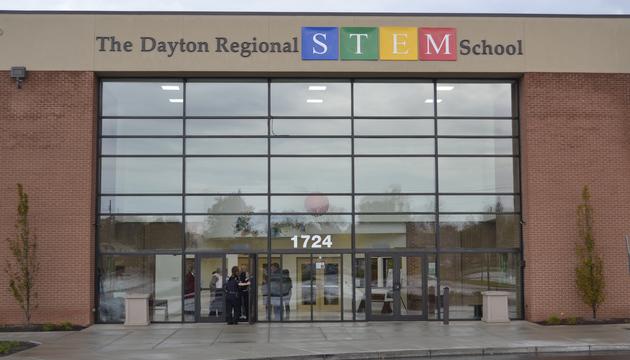
Submitted by Lorraine Wagley
On October 28, 2014, a group of retirees visited the Dayton Regional STEM School on Woodman Drive in Kettering. Many of us had a preconceived idea of what we would see and hear about this ever-growing type of school. After our visit we were pleasantly surprised to find that our ideas were incorrect. Besides science, technology, engineering and math the students study arts and the humanities. What is more unique is the way courses are taught in which group cooperation and interaction is stressed and the results of student learning result in appropriate application.
We were welcomed by the Chief Administrative Officer and by former WSU Education Dean Greg Bernhardt. Our group of about 18 persons was split into several small groups, each led by students ranging from 7th graders to high school seniors. The tour was quite inclusive. Not only did we visit the several commons areas, but we also visited classrooms where we were encouraged to talk to the students and teachers. We were told that visitors are always welcome at the school.
Many interesting observations were made during the tour. We were all very impressed with our tour leaders and the maturity of the students in the classrooms. We noted that lockers that line the halls of traditional high schools were missing. Instead, rows of “cubbies” were evident in many areas. We asked if theft was a problem and the answer was “no” although our 7th grade tour guide did say she had had a cookie stolen from her cubby!
In several of the commons areas we saw various art exhibits including sculptures, drawings, paintings and prints all resulting from various practical classroom projects. Entering several classrooms we noted that tables replaced the typical desk arrangement. Most students were working in small groups and readily answered our questions about the projects they were working on. Textbooks were not evident and we were told that they are not used in many classes.
After the tour we met with Principal Hope Strickland, and Robin Fisher, Chief Administrative Officer. It was then that we learned more interesting facts about the school and its philosophy. All teachers are on a one-year contract and serve without tenure. On applying for a teaching position the individual must present a project. Parents and teacher are present at the interview. Curriculum planning is done by grade level and not by subject matter.
The criteria for a student to be admitted to the school is quite interesting. Both the student and his parents must submit an essay as to why the STEM school was chosen. SAT and ACT scores are not taken into account. Admission is by a lottery system, although a certain number of students are accepted based upon participating school districts, ethnicity and sex. Only about 50% of applicants were accepted this year.
During the years at STEM the student job shadows during the 9th and 10th grade. During their Junior or Senior year they must compete 72 hours of an internship either during weekends or the summer. Students must initiate their own contacts with companies for these requirements. The school does offer a list of companies that will accept students.
Collaborating with businesses and other institutions is common. At the present time students are working on projects for the Newport Aquarium and Grumman, the defense contractor.
Ninety percent of the students go on to college and STEM school students may take classes at WSU for college credit. The cost of educating each student is $7,000 of state support and the school enrolment this year is just over 600 students, grades 6 to 12. The school carries a mortgage of $300,000 a year for ten years.
One teacher mentioned that some of the people at the wanted to change the name from STEM to SHTEM to include the Humanities or to STEAM to include the Arts, but Bernhardt said SWEATER was also suggested to include ‘weedin’ and ‘ritin’.
It was an inspiring visit and at its conclusion several people commented that they wanted to go back to school…to this STEM school!
— By Lorraine Wagley

